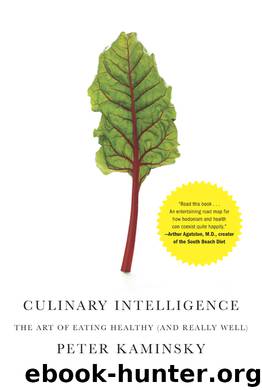Culinary Intelligence by Peter Kaminsky

Author:Peter Kaminsky [Kaminsky, Peter]
Language: eng
Format: epub
ISBN: 978-0-307-95848-8
Publisher: Knopf Doubleday Publishing Group
Published: 2012-04-30T16:00:00+00:00
UMAMI
Umami, which was first identified by Japanese scientists more than a century ago, often signals edible protein. All meat, fish, dairy, fruits, and vegetables have some protein, so they all have some umami. On an intellectual basis I understood this, but it wasn’t until recently that I could say that I recognized it. I took my first steps after a meal at Blue Hill last summer. I found myself thinking about the intense flavor of the little swab of sauce that was served with a chicken breast. Apart from a little saltiness it had few of the taste characteristics of Ducasse’s cherry sauce. Where Ducasse’s creation was layered and full of different taste notes, Dan Barber’s sauce struck one massive chord. Not better nor worse, just different. Very savory, with a beautiful mouth-feel. If asked to describe it more precisely, I’d fumble for words and say that it was “chickeny.” Not salty, not sweet, not sour—just whatever it is that makes chicken taste like chicken. I asked Dan how he did it.
“We break the stock three times and each time we break it, we intensify.”
“Dan, what the hell is breaking?” I asked.
“We reduce the stock until it breaks,” he answered tautologically.
“Uh … well … uh …”
He sensed my bafflement. “Why don’t you come by the restaurant some morning and we’ll walk you through it.”
Later that week, my daughter Lucy and I met Trevor Kunk, one of Dan’s chefs at Blue Hill. It’s a serious restaurant kitchen. If you stand anywhere near the stovetop you can well imagine that this is what it must feel like to stoke a blast furnace.
Over the next four hours Lucy and I watched and tasted.
First Trevor made a bouillon.
It tasted like chicken soup.
Then he simmered roasted chicken bones and a caramelized onion in the strained bouillon.
It tasted like chicken soup, only more so.
He oiled a large pan and filled it with a layer of raw chicken wings and drumettes and browned them at high heat. The idea here was to get a good Maillardized crust. If you are not familiar with the Maillard reaction, it is the chemically complex process that occurs when heat, sugar, and protein interact. It is responsible for the crust that builds up on meat and some vegetables when they are subjected to heat. It is also the secret to the complex flavor of long-cured meats, such as ibérico ham. It is essential to getting maximum Flavor per Calorie. When Trevor was satisfied that the browning was done, he covered the bones with strained roast-chicken stock and boiled rapidly to reduce the liquid.
“We boil it to the breaking point,” he said.
“Which is …?”
He nudged a chicken wing away from the side of the pan. As it pulled away, the liquid had thickened so much that it reminded me of strings of mozzarella trailing off a slice of hot pizza.
We tasted again.
It was … hmm … extra chickeny.
Trevor explained, “When those strings snap, you’re at the breaking point. If you let it cook further, the emulsion will separate.
Download
This site does not store any files on its server. We only index and link to content provided by other sites. Please contact the content providers to delete copyright contents if any and email us, we'll remove relevant links or contents immediately.
The Body: A Guide for Occupants by Bill Bryson(5027)
Audition by Ryu Murakami(4887)
Adulting by Kelly Williams Brown(4530)
Housekeeping by Marilynne Robinson(4391)
1578 Plant Pattern Recognition Receptors by Unknown(4326)
Be in a Treehouse by Pete Nelson(3996)
Zero Waste Home by Bea Johnson(3804)
Seriously... I'm Kidding by Ellen DeGeneres(3606)
Better Homes and Gardens New Cookbook by Better Homes & Gardens(3547)
The Healing Self by Deepak Chopra(3523)
Barkskins by Annie Proulx(3334)
Hedgerow by John Wright(3316)
The Cellar by Natasha Preston(3296)
Spark Joy by Marie Kondo(3270)
The Genius of Japanese Carpentry by Azby Brown(3254)
The Life-Changing Magic Of Tidying Up- The Japanese Art Of Decluttering And Organizing (v5.0) by Marie Kondo(3233)
120 Days of Sodom by Marquis de Sade(3223)
Work Clean by Dan Charnas(3079)
The Book of Numbers by Peter Bentley(2928)
